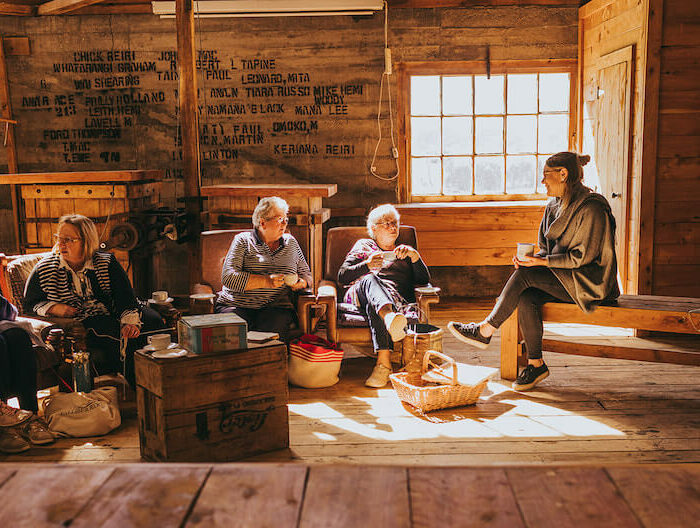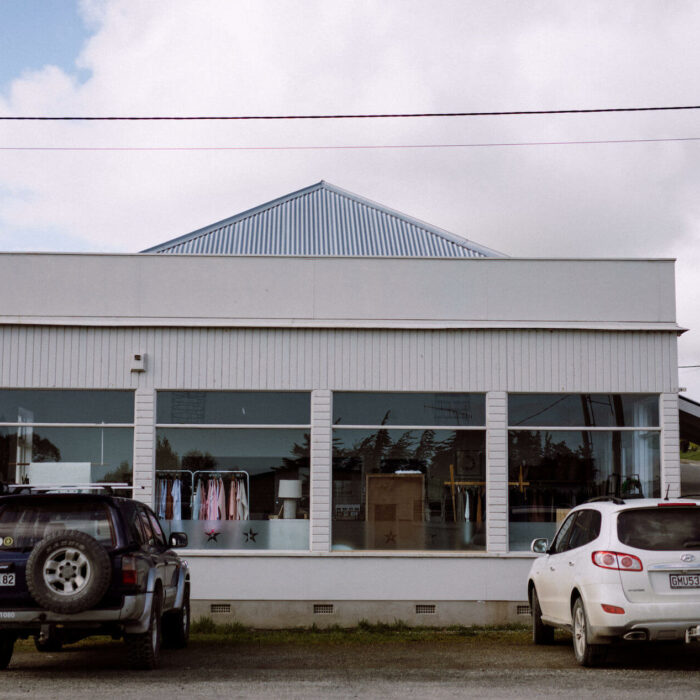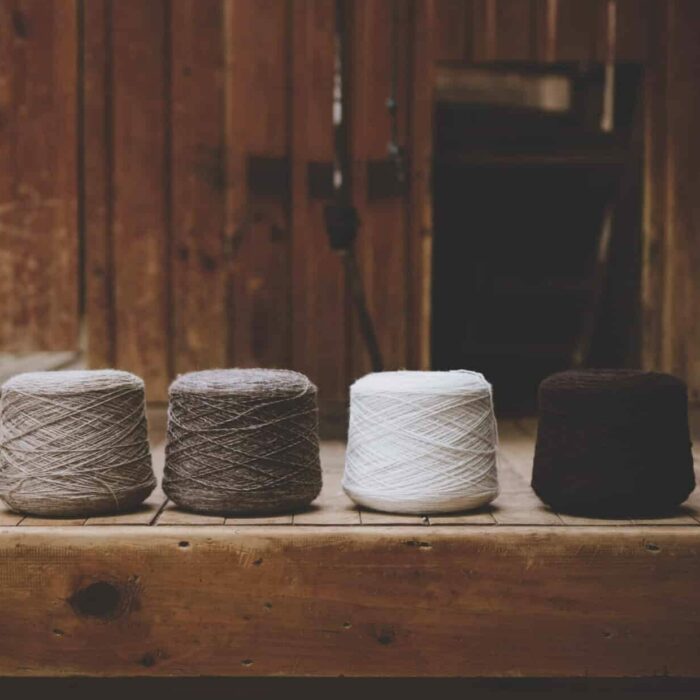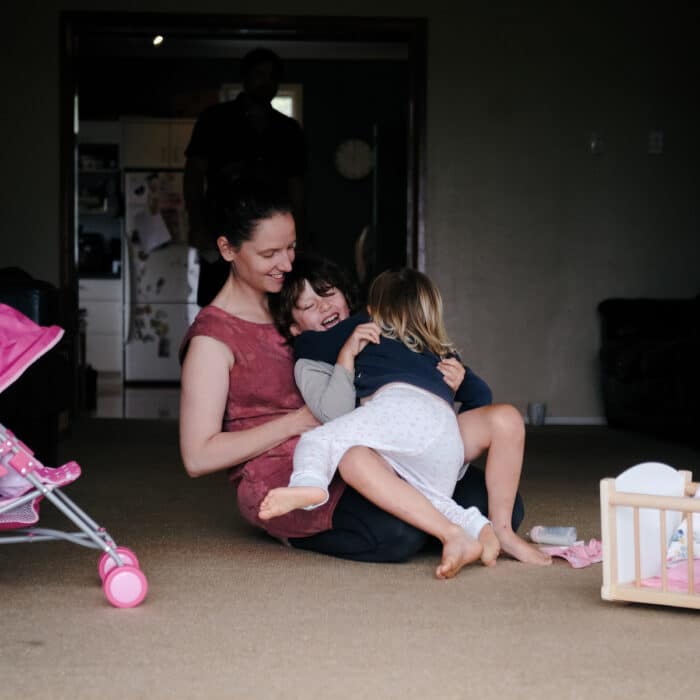12 October 2023
Becoming a Mother
Mano Whenua. Heartland.
writer: Sioninn Mentor-King
photographer: Michelle Holt
When Eloise Keefer and her husband, Leon, purchased virgin land near Whangārei Heads, they wanted to have a go at living in a yurt off-grid. Over the past three years, they’ve set about developing the block, welcoming baby Rosamund along the way. Eloise opens up about giving birth via emergency C-section and the imposter syndrome, disappointment and terror that come with a birth far removed from what you planned – and the joys that come afterwards.
Content advisory: This story involves discussion of difficult birth and medical trauma. Whilst we strive to explore these subjects sensitively, we recognise this story may be challenging for some readers.

Top image. “I don’t need to live in a big fancy house,” says Eloise. “I’m really enjoying my yurt – it’s such a cool space to be in. I love lying in bed and looking up at the dome and seeing the stars. I had to design and figure out where I wanted all the windows and doors and when we put it up, the maker was like, ‘Oh, the windows are placed perfectly.’ I was really proud of that moment. And now when I wake up, I can see the sunrise. I don’t even have to move my head.” Above. Eloise has a cuddle with Rosamund.
Eloise has had a long fascination with yurts. “They’re just such cool spaces, really interesting structures. You feel so much more connected to nature when in them due to the exposed wood and natural cotton fibre walls,” she explains. “I studied passive house designs in Vienna while on exchange during my masters program. One girl there was from Kyrgyzstan, and she spoke about yurts, and that kind of just solidified my idea about living in one. I just loved the concept of them being these structures that you could pack away in a day and move.”
The cost of housing in Auckland, where Eloise, 29, and Leon, 37, were living and working, meant that the couple were looking to build their life and career outside of the big smoke. “You can get locked into this really big mortgage and we didn’t really want that for ourselves. We wanted to have flexibility with our finances.” At the end of 2020, when the engineering and development company they were working for wanted to open a branch in Northland, they jumped at the chance to find their own place. Leon took a position in the new branch, and Eloise took a role as a community ranger with the Department of Conservation.
They were on the look-out for virgin land, between four and ten hectares in size, and stumbled across a block at Whangārei Heads. “Leon and I both grew up rurally. He spent every summer working on his family’s farm, so the idea of homesteading – and to get out of the city and be able to afford an opportunity to buy land – to him and to me was a dream.” The property they found came with a barn, solar power, a dam and a pump. “No land is easy out here because it’s so steep and hilly and clay,” Eloise says. “But we found something that already had all the infrastructure set up which made our transition into the farm much easier.” They moved into the existing barn, which had a kitchen of sorts and an outdoor flushing toilet, and then, down the hill, they set about establishing the yurt. Then came baby Rosamund – the deciding factor in sticking with their current set-up. “We deferred the plans we had to build a house, as we had everything we needed between the yurt and converted barn.”

Despite a relatively normal and seemingly eventless pregnancy, at thirty-nine weeks Eloise went for a routine check-up with her midwife and was informed her baby wasn’t growing. “I couldn’t believe that,” Eloise says. “I felt huge. When my midwife said I hadn’t grown, I’d had a different midwife measuring me the previous weeks, so I thought perhaps there’d been an error measuring her.”
Although she wasn’t expecting complications with her birth, Eloise was no stranger to the concept. She herself was born by emergency C-section. “The scan results came back and within two hours my midwife called me, and said there was an issue with the nutrient exchange from the placenta across to the umbilical cord. Her abdomen was measuring small, which was an indication she wasn’t able to get nutrients. I remember my midwife saying smaller babies really struggle in childbirth.” The baby was essentially starving in the womb, and needed to be born really soon.
Eloise says, “I remember asking my midwife, ‘Why has this happened? Have I done something wrong for her to stop growing?’ I’d been doing a lot of physical farm chores and work on the barn during the pregnancy, and thought maybe it was my fault for not resting enough. Maybe I had exerted myself. We’d been under a lot of pressure to get everything finished enough for the baby to come. She just said, ‘Outside of smoking and drinking a lot, which you don’t do, we don’t know why these things happen. They just happen. A placenta’s got a certain life expectancy at the end of your pregnancy. It’s just getting old.’”
Eloise has plans to improve their food self-sufficiency. “I’m gonna get more hens and have eggs again, and I’ve been terracing a bank for gardens. Then I’ll put a greenhouse up, because if this past non-existent summer has taught me anything about successful gardening, it made me realise I definitely need greenhouses to get things growing.”
Nothing about Rosa’s birth was routine. On Monday, Eloise turned up to the hospital at 10am to start the induction. The medication Eloise was given to induce the labour worked far faster than intended, and within eight hours they were trying to stop her contractions. “They gave me an injection into my stomach to stop the contractions. I was thinking, ‘What? No, no, this is good. I’m having the baby.’ And the doctor said, ‘No. Your uterus should not be working this fast and hard. The contractions are too close together, and very long, and your baby’s heart is not coping – she’s not able to recover between contractions. She’s in distress. Your baby’s run her marathon and we need to get her out.’”
“She was talking about doing an emergency C-section, and getting the paperwork ready for me to sign. I remember feeling a flood of emotion, and being so terrified and so tired, that I started to cry. I had mentally prepared myself to birth this baby naturally. I was gutted. I was afraid that something would go wrong. I was disappointed that I couldn’t birth her naturally.”
For Eloise, who had never undergone any sort of surgery or had a general anaesthetic, and was always terrified of needles, going to theatre was hugely invasive. “There’s a lot of strangers around you, they are having to prepare you very quickly for surgery. I was mostly naked. My body was not my body.” Eloise wasn’t sure she had the mental or emotional capacity to withstand the operation. “Someone was going to be cutting open my stomach,” she recalls. “What if I can feel it? What if something goes wrong and the spinal block doesn’t work? Or if I lose too much blood? I was really, really terrified but I thought, ‘I’ve got to pull it together, otherwise this baby won’t make it.’ Leon was by my side, holding my hand, talking to me the entire time. I couldn’t have done it without him.”
Baby Rosamund did make it, but not after giving her mother another scare. For Eloise the moment is still raw. “I was expecting Rosa to be brought up my chest, to do skin-to-skin.” But they immediately took her to a table in the room and began working on her as she wasn’t breathing. “I was watching the clock above the lamp, and I remember it was twenty-two minutes of them trying to resuscitate her. I was really scared. I was thinking ‘Holy shit, am I gonna lose this baby?’ They were doing compressions and giving her oxygen. And I remember I could see her little hand was holding her doctor’s finger. I thought, ‘Well, she’s moving.’ I remember asking Leon if he could see her, as I couldn’t move.”

After twenty minutes, Eloise remembers the doctor said, “I can’t get her breathing on her own. We’re going to send her to the Special Care Baby Unit (SCBU).” Leon was sent to post-op recovery. “I was just lying there, thinking, ‘My baby’s not here... My husband’s not here... I’m still getting stitched up...’” It was sometime later, while she was still waiting for her spinal block to wear off, that Eloise was informed Rosa had left SCBU and was waiting for her in the maternity ward. After an incredibly traumatic entrance to the world, Eloise finally got to meet her baby.
Some women who have non-elective C-sections can face a sense of imposter syndrome – I didn’t deliver this baby myself, so am I really qualified to be her mother? Eloise was not an exception. “I felt really worried that I would have less of a connection with her,” she says. “I read Stand and Deliver, and it made me feel really excited and empowered about the labour, the journey that she and I were gonna go on. I remember worrying, ‘Because I haven’t birthed her naturally, will I feel the same way?’”
Fortunately, Eloise has blossomed as a mother. “Honestly, it doesn’t matter what time she wakes me up in the night, I’m never upset about it. While we definitely have had some tough nights during her sleep regressions, she is the biggest joy in my life and my greatest love. Something clicked after she was born where I just have unlimited patience for this little baby. It’s quite incredible.”
“We have seven sheep, and four cows – Angus Jersey cross – and they’re currently pregnant,” Eloise says. “We plan on raising those calves selling them and that will provide a bit of cash. And then we’re also at that point going to do home kill for one of the girls, sadly – we really have become attached to our cows. But that will be our meat.”
“I want Rosa to know how to turn on a water pump, fix a leaking pipe, move cows, learn to grow her own food.”
Eloise’s own physical recovery has been more of a challenge, especially straight after the surgery. “Getting off the couch was really hard. Getting up in the night to feed Rosa, I’d have to roll to my side, which would take a really long time because you have to use your ab muscles, and then I would swing my legs off the bed and get on to my knees and then use my thighs to push myself up. And then when I got to about six weeks, I felt really good. I went back to teaching yoga, but I still found that I had no ab strength. I’ve now developed it enough but still, whenever I pick up certain things, I have to be really, really careful of the scar tissue. I used to be very physical and strong, and I’ve had to adapt the way I go about farming and building.”
Ten months on, Eloise, Leon, Rosa and their two dogs – Winnie and Margot – are going strong, working to develop their land and dwellings. “Leon and I enjoy living the way we do,” Eloise says. “It’s unconventional, I know, but we hope that our daughter can grow up to appreciate natural resources and have access to nature the way we do. Being off-grid, we have to be conscious of our power and water usage. I want Rosa to know how to turn on a water pump, fix a leaking pipe, move cows, learn to grow her own food and understand the impact of the seasons on farmers.”
Since having Rosa, Eloise has resigned from her job with DOC, in order to be at home with her daughter and to manage their block. For now, their land with baby Rosa is where she wants to be. “With everything we want to achieve on the farm, someone really needs to be here to keep the gardens going and move the cows. That’s what Rosa and I do. We were out there yesterday; she was strapped to me and we were putting up white tape up and moving the girls. She loves it. She loves seeing the cows; we give them a big scratch and we feed them, don’t we?” Eloise asks her daughter. Rosa gives her mother a serious look: “Don’t all farmers do that?” she seems to say. “Whenever I move the cows, they come up to her. I’ll be doing something with the fence, and the next minute I can see the cows licking her hand. And she’s laughing, and I’m like, ‘Oh my god, please don’t eat my baby.’”
Working off-farm is something she will look to return to in future, but right now, Eloise is happy to be at home, on the land. “I love working, and look forward to jumping back into my career, whichever direction I take, but I can do that anytime. I think the first two years of my life with Rosa, of her life with me, is really important. Building a relationship with her, teaching her, taking her with me and being involved in the day to day running and managing of the farm. That’s the whole point of living the way we do, to raise our children here on the farm, to teach them from a young age how it works. I have a few years with Rosa before she goes to school. I can jump into my career at any time, but I can’t get these two or three years back. That’s why I’m taking a little bit of extra time.”
Eloise dancing with Rosamund in their kitchen, which they’ve filled with decorations and personal touches, including instruments. “Leon is a musician. He sings in a band and he plays the banjo, the ukulele and he can play a bit of piano, too. He’s just quite musical.”
If you enjoyed this story, please share with someone else.
This story appeared in the Kōanga Spring 2023 Edition of Shepherdess.
Get your hands on a copy.
Related Stories
Lisa Portas
Lisa takes us into the century-old woolshed on Palliser Ridge, where she hosts a monthly community knitting group.



